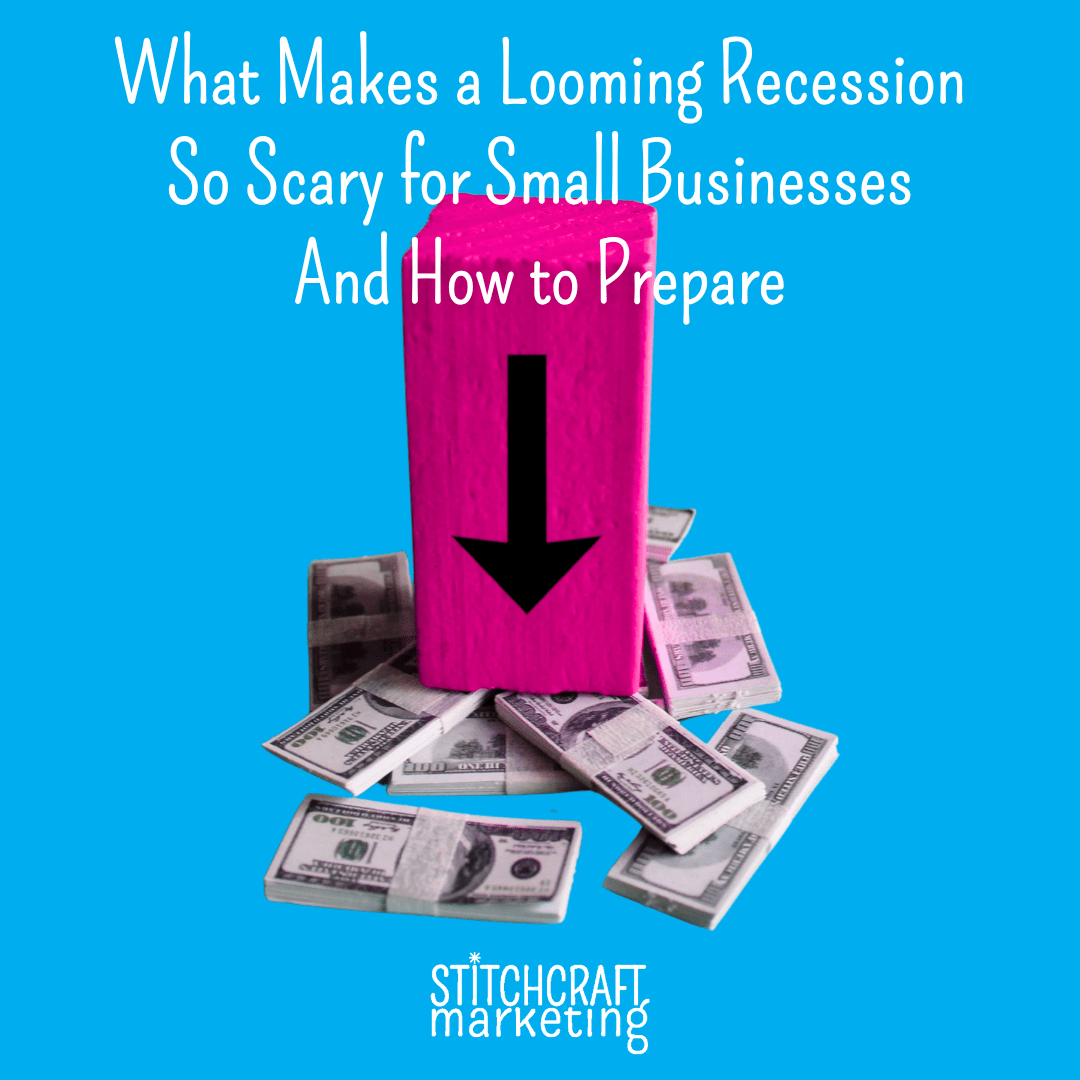
11 Jun What Makes a Looming Recession So Scary for Small Businesses—And How to Prepare
For small business owners—especially those in the craft and handmade sector—a looming recession can feel like a dark cloud gathering overhead. A recession brings uncertainty, tight budgets, and potential disruption to the business you’ve poured your heart into. But understanding what makes a recession so intimidating is the first step toward preparing for it. Even better, with the right tools, strategies, and mindset, you can weather economic storms more confidently and even find opportunity amid the challenge.
Why Are We Talking About a Recession Now?
Recession concerns aren’t just media hype—they’re grounded in real economic signals that small businesses, especially in the craft and handmade sectors, should heed.
Key Economic Indicators Pointing to a Potential Recession:
- Yield Curve Inversion: The yield curve, which plots interest rates of bonds with different maturities, has inverted, creating a scenario where short-term interest rates exceed long-term ones. Historically, such inversions have preceded every U.S. recession since the 1960s, making it a reliable predictor of economic downturns. (Forbes; Morningstar)
- Gross Domestic Product (GDP) Contraction: The U.S. economy contracted by 0.3% in the first quarter of 2025, indicating a slowdown in economic activity.
- Consumer Spending Patterns: While consumer confidence has shown some improvement, spending remains cautious. Consumers are focusing on essential goods and value-driven purchases, which can impact discretionary sectors like crafts.
- Trade Tensions and Tariffs: Ongoing trade disputes, particularly with China, have led to increased tariffs, raising costs for materials and causing supply chain disruptions. These factors contribute to economic uncertainty and can affect small businesses reliant on imported goods.
- Federal Reserve Leadership Transition: Federal Reserve Chair Jerome Powell’s term is set to end in May 2026. President Trump has expressed intentions to replace him with Kevin Warsh, a former Fed governor known for his hawkish stance on inflation. Such a leadership change could influence future monetary policy decisions, affecting interest rates and economic stability. (Investopedia)
Understanding these indicators helps small business owners anticipate potential challenges and adapt their strategies accordingly. By staying informed and proactive, businesses can better navigate economic uncertainties and position themselves for resilience.
Why a Recession Is So Daunting for Small Businesses
1. Decline in Consumer Spending
During economic downturns, consumers become more conservative with their money. Discretionary spending—on items like handmade goods, art, and luxury craft supplies—is usually the first to be trimmed. If your business relies heavily on customers purchasing for joy, gifting, or hobby purposes, you might see a noticeable dip in sales.
2. Cash Flow and Credit Crunch
Small businesses often operate with tighter profit margins and limited cash reserves. When a recession hits, it’s not just sales that slow down. Customers may also delay payments, and credit lines may shrink or become harder to secure. Without strong cash flow or access to funds, small businesses can quickly find themselves in a precarious position.
3. Rising Costs and Supply Chain Disruptions
Economic uncertainty tends to ripple through supply chains. Costs for materials, shipping, or packaging may rise unexpectedly, or you might struggle to source key supplies, especially if you rely on imports. These fluctuations can wreak havoc on budgeting and pricing strategies.
Recession-Proofing Your Craft Business: Strategies That Work
Now for the good news: preparing for a recession isn’t just possible—it can make your business stronger and more agile in the long run. Here’s how to navigate economic uncertainty with resilience and resourcefulness.
1. Tighten Your Financial Operations
Start with a financial check-up. Track every dollar coming in and going out. Use simple accounting tools like QuickBooks, Wave, or Xero to monitor cash flow in real time. Set aside an emergency fund, if possible. Even a few months’ worth of expenses can make a difference.
Reassess your pricing and cost structure. Can you cut back on unnecessary expenses or negotiate better rates with suppliers? Consider running lean without compromising the quality your customers expect.
2. Diversify Your Income Streams
If you rely solely on product sales, consider expanding your business model. Offer digital patterns or downloadable resources if you’re in the fiber arts. Host virtual workshops, classes, or paid tutorials. Consider creating exclusive subscription boxes or loyalty clubs for your best customers.
Adding a passive or recurring revenue stream helps cushion the blow if direct product sales take a dip.
3. Double Down on Your Best Customers
During tough times, your loyal customer base becomes even more valuable. Focus on nurturing these relationships through email marketing, personal outreach, and tailored offers. Tools like Klaviyo or Mailchimp allow you to segment your audience and send timely, relevant messages.
Also, encourage reviews and user-generated content. A community-driven approach helps deepen trust and increase repeat purchases—even when budgets are tight.
4. Get Smart with Inventory and Supply Chain
Avoid overstocking and instead adopt a just-in-time or made-to-order model if possible. Pre-orders can guarantee sales of novel or exclusive products in limited numbers. This reduces the risk of unsold inventory and helps with cash flow.
Connect with multiple suppliers and keep an eye on your most critical materials. If you can, find local or alternative sources to reduce reliance on vulnerable supply chains.
5. Market with Empathy and Authenticity
During a recession, tone matters. Shift your messaging from aspirational to supportive. Highlight the practical, emotional, or heirloom value of what you create. People may still spend, but they’ll be more intentional about it.
Social media remains a powerful tool. Use platforms like Facebook, Instagram, Pinterest, and TikTok to share behind-the-scenes looks at your process, customer stories, and how your products can bring comfort or joy in uncertain times.
Why Cutting Marketing During a Recession Can Backfire
In times of economic downturn, it’s natural for businesses to look for ways to reduce expenses. Marketing and advertising budgets often become prime targets for cuts. However, history and research consistently demonstrate that slashing marketing efforts during a recession can be detrimental in the long run.
Historical Insights: The Long-Term Benefits of Sustained Marketing
- 1980s Downturn: During the 1980s recession, companies that maintained or increased their advertising budgets saw significantly better performance than those that reduced spending. Specifically, these companies performed 256% better than competitors who cut back on advertising. (Gigasavvy)
- 2008 Financial Crisis: A study of 3,900 companies worldwide during the 2008 recession revealed that those who continued to invest in marketing achieved a 17% compound annual growth rate during the downturn. These companies focused on cost containment but continued to play offense by optimizing their marketing spend. (Medium Giant)
Modern Examples: Brands That Thrived Through Strategic Marketing
- Samsung: During the 2008 recession, Samsung maintained its marketing spend and focused on rebranding itself as an innovation leader. This strategy paid off, elevating the company from No. 21 to No. 6 in global brand value rankings. (Medium Giant)
- Kellogg vs. Post: In the Great Depression, Kellogg doubled its advertising budget and introduced new products, leading to a 30% profit increase by 1933. Meanwhile, Post cut back on advertising and lost market share, allowing Kellogg to become the market leader. (The New Yorker)
The Strategic Advantage: Less Competition and More Visibility
During recessions, many companies reduce their advertising efforts, leading to less competition for consumer attention. This environment provides an opportunity for businesses that maintain or increase their marketing efforts to access a larger audience and strengthen their brand presence.
Building Consumer Trust and Loyalty
Consistent marketing during tough economic times signals stability and reliability to consumers. A survey by Harris Interactive/Yankelovich found that 86% of people feel better about companies that continue to advertise during a recession, and these companies are more likely to be top-of-mind when purchasing decisions are made. (Crimtan)
Key Takeaway: While it might seem prudent to cut marketing expenses during a recession, doing so can hinder long-term growth and brand strength. Historical data and modern examples underscore the importance of sustained marketing efforts to navigate economic downturns successfully.
Mindset Matters: Stay Grounded and Open
In challenging times, it’s not just strategy—it’s mindset that sustains you.
- Stay connected: Join communities of fellow craft business owners. Forums like Craft Industry Alliance, private Facebook groups, local maker collectives, and your local SBDC are invaluable for advice, support, and cross-promotion.
- Stay agile: Be willing to pivot. Maybe your best-selling product last year isn’t working this year. Test new ideas, listen to customer feedback, and adjust.
- Stay visible: Don’t go dark. Consistency in communication reassures customers and keeps your brand top of mind when they’re ready to spend again.
Final Thoughts
Recessions are tough, but small businesses are tougher. Especially in the craft world, where creativity, connection, and passion run deep. By understanding the risks and taking proactive steps to shore up your finances, broaden your offerings, and strengthen customer loyalty, you can survive a recession and emerge more resilient, focused, and inspired than ever. Do you need help strategizing ways to recession-proof your business? Stitchcraft Marketing is a marketing agency of crafting experts. We customize every program to showcase your brand, engage your customer base, and generate sales in a way that is nothing less than magical. Contact us today!


No Comments